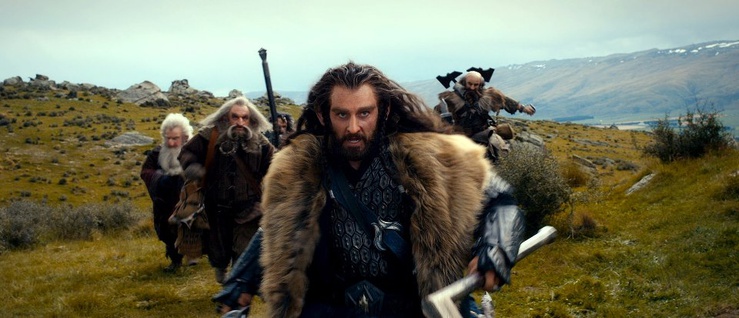
Tolkien’s Hobbit, and its biblical and heavy metal aftertaste
Published on
Translation by:
 Mr Zee
Mr Zee
12/12/12 is a morbid day in the run-up to the end of the world on 21 December; it is also the day when 'The Hobbit – an Unexpected Journey 'hits cinemas. Peter Jackson’s latest film based on the prequel of 'The Lord of the Rings', also by J.R.R. Tolkien, has apocalyptic threads running all the way through it
You’re all aware that the end of the world is nigh. Before it disappears completely, big budget cinema has given us one last fantastic adventure by releasing The Hobbit: An Unexpected Journey on 12 December 2012 (in Belgium, Denmark, Finland, France, the Netherlands, Norway and Sweden). Peter Jackson sticks to his tried and trusted cast of actors, which is really significant at a time when festivities are about to begin. Run of the mill stuff is being churned out at a pace akin to someone jumping into a nuclear shelters. In the UK, The Lord of the Rings trilogy had a PG certificate (parental guidance) when the films were released between 2001 and 2003. The Hobbit, which is based on the prequel to the story, also by J.R.R Tolkien, is being released with a 12A certificate (meaning children under twelve can view the film if accompanied by an adult).
Finding God in The Lord of the Rings
One good reason why the New Zealander's film will make sense at the end of this year is down to its thoroughly biblical character. Whenever we’re in any kind of mortal danger, even the fiercest atheist has been known to start praying. Once they’ve seen the film most people will probably see the light too because the literary sum on which Jackson is drawing on in his films lives and breathes catholicism and the bible. It’s not only the length of the book which is comparable (The Lord of the Rings is 1. 278 pages long, whereas the standard format Jerusalem bible counts 1, 801 pages). The bible and Tolkien’s stories also share a number of other similarities.
John Ronald Reuel Tolkien was born in South Africa in 1892. His mother, who had a close attachment to the Latin mass, was responsible for his education. Tolkien became a devout catholic from early on. By temperament he was conservative and traditionalist. He spent a few years in the army during the first world war, from 1915 onwards. Passionate about languages (he graduated from Oxford with a first class degree in English), he excelled in his studies and taught at Oxford university (later becoming professor of Anglo-Saxon at Pembroke College). This intense interest is reflected in his eye for detail. Each of the three volumes of The Lord of the Rings includes extensive appendices which give background information on the history, culture and languages of Middle Earth. These give a sense of coherence and plausibility to the world that Tolkien created.
Frodo the Hobbit, the diminuitive hero of The Lord of the Rings, clearly has a christ-like dimension
When Tolkien started to write The Hobbit in 1937 he was very much influenced by the bible. To be perfectly blunt Frodo the Hobbit, the diminuitive hero of The Lord of the Rings, clearly has a christ-like dimension. He was given his mission at the age of 33. The role he was to play in the destiny of the world had been prophesied. To protect Middle Earth from evil he has to go through a lot of suffering. The heroes in the book embody typically christian values: humility, sacrifice, and tolerance. Their quest is a quest to save the world, a struggle between Good and Evil, and is indisputably biblical.
Reluctant saviour
Two other examples illustrate just how much the bible permeates this story. It’s a hobbit that’s chosen to be the one to bear and eventually destroy the ring. Put it another way, the chosen one is a peace loving human-like being, who loves nothing more than staying at home, is not really into adventures, and deep down is even a bit naïve. If you think of St Paul’s words in his First Epistle to the Corinthians, it’s hard not to make comparisons: 'But God chose things the world considers foolish in order to shame those who think they are wise. And he chose things that are powerless to shame those who are powerful' (from American writers Kurt Bruner and Jim Ware's Finding God in 'The Lord of the Rings, 2006). Although Frodo accepts his mission freely, he does so somewhat reluctantly. He feels a call to be the saviour of Middle Earth, which he cannot resist.

The second example is towards the end of Book 1, Chapter 12 ('Flight to the Ford'). Frodo is on the white horse given him by the Elves. and is being chased by nine Black Riders (servants of the Dark Lord, Sauron). Frodo gets across the ford safely. But when the riders get to the water they are immediately submerged by the rising current: 'The black horses were filled with madness and leaping forward in terror they bore their riders into the rushing flood.' There is a direct link here with the account in the Hebrew bible of the Israelites crossing the Red Sea and the route of Pharaoh’s army (from French philosopher and Anglo-Saxon literature specialist Irene Fernandez's The Hidden Meaning behind Tolkien's Work, 2002, and Tolkien, Fairies and Christianity by S.Caldecott, D.Rance and G.Solari, 2002).
Screaming metal
It would be very easy to suggest that Tolkien preaches the 'Good News' and that after reading the trilogy your child will snugly end up in the church choir. For a number of years now the British author has been a source of inspiration for quite a few metal groups, which is seen as the devil’s own music. Metal musicians often look to the catholic writer for their stage names, Mordor, Saruman and Sauron amongst others, which conjure up darkness and shadows.
A member of the Norwegian group Dimmu Borgir was named after Shagrat, one of the Orc captains. Place names crop up frequently in heavy metal music: Barad-dûr, Cirith Gorgor (from the Netherlands), Cirith Ungol, Gorgoroth (from Norway), Isengard , Ephel Duath (from Italy) and Morgul. The Dark Lord Sauron may have been beaten by the Fellowship of the Ring, but he lives on in a dark genre of extreme music, which is a world away from our cuddly furry footed hobbit friends.
The Hobbit is released in the rest of Europe on 13 December (Bosnia and Herzegovina, Croatia, Czech Republic, Germany, Greece, Hungary, Ireland, Italy, Portugal, Serbia, Slovakia, UK and Slovenia) and 14 December (Bulgaria, Estonia, Lithuania, Romania, Spain and Turkey), 19 December (Russia), 20 December (Ukraine) and Poland (28 December)
Images: main and in-text courtesy of © Lord of the Rings official facebook page; book cover courtesy of © amazon/ videos: (cc) CinemasGaumontPathe; Gorgoroth (cc) bezo999/ youtube
Translated from Le Hobbit de Tolkien, entre la Bible et le metal


